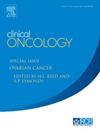Management of Head and Neck Squamous Cell Carcinoma With N3 Nodal Disease
IF 3.2
3区 医学
Q2 ONCOLOGY
引用次数: 0
Abstract
Aims
Radical management of the N3 neck for head and neck squamous cell cancer (HNSCC) remains unclear. We aimed to investigate the use of primary surgery including neck dissection versus primary radiotherapy followed by imaging.
Materials and methods
We retrospectively reviewed consecutive patients with HNSCC and N3 nodal disease, excluding nasopharyngeal primaries. Patients had either surgical management of the primary and neck dissection followed by postoperative radiotherapy or primary radiotherapy followed by surveillance if complete response was found on post-treatment imaging. Patients were imaged at a mean of 16 weeks post radiotherapy. Patients identified with presence of resectable residual disease on imaging were treated with neck dissection.
Results
Between July 2012 and February 2023, 53 patients with T0-4N3M0 HNSCC were treated radically. The median (range) follow-up was 25.5 (3-146) months, with an opportunity for follow-up of 64 (19-147) months. Twenty-two patients had primary surgical management and 31 had primary radiotherapy. Two-year overall survival was 64% in patients treated with primary surgery, 55% in patients treated with primary radiotherapy, 87% in patients with complete response after radiotherapy, and 92% in complete responders who were p16 positive. Response assessment was done with positron emission tomography-computed tomography (PET-CT) in 77% of patients and predicted subsequent disease-free survival better than computed tomography (CT). p16-positive patients were more likely to achieve complete response (63% vs 25%), but extracapsular spread was not predictive of response.
Conclusion
Surveillance for patients with complete response on postradiotherapy PET-CT is a reasonable approach, especially for p16-positive patients, sparing them the morbidity of neck dissection. Patients with p16-negative disease are less likely to achieve a complete response and may be better managed with primary neck dissection.
头颈部鳞状细胞癌合并N3淋巴结病的治疗
目的N3颈部头颈部鳞状细胞癌(HNSCC)的根治性治疗尚不清楚。我们的目的是研究包括颈部清扫在内的初级手术与初级放疗后影像学的对比。材料和方法我们回顾性分析了连续的HNSCC和N3淋巴结疾病患者,不包括鼻咽部原发病例。患者要么进行手术治疗原发性和颈部解剖,然后进行术后放疗,要么进行原发性放疗,如果在治疗后影像学检查中发现完全缓解,则进行监测。患者在放疗后平均16周进行影像学检查。在影像学上发现存在可切除的残余疾病的患者采用颈部清扫术治疗。结果2012年7月至2023年2月,53例T0-4N3M0型HNSCC患者接受了根治性治疗。中位(范围)随访时间为25.5(3-146)个月,随访时间为64(19-147)个月。22例患者行手术治疗,31例患者行放射治疗。初次手术患者的两年总生存率为64%,初次放疗患者为55%,放疗后完全缓解患者为87%,p16阳性完全缓解患者为92%。77%的患者采用正电子发射断层扫描-计算机断层扫描(PET-CT)进行反应评估,预测随后的无病生存期优于计算机断层扫描(CT)。p16阳性患者更有可能达到完全缓解(63% vs 25%),但囊外扩散不能预测缓解。结论对放疗后完全缓解的患者进行PET-CT监测是一种合理的方法,特别是对p16阳性患者,可避免其发生颈部夹层。p16阴性疾病的患者不太可能获得完全缓解,可能通过原发性颈部清扫来更好地管理。
本文章由计算机程序翻译,如有差异,请以英文原文为准。
求助全文
约1分钟内获得全文
求助全文
来源期刊

Clinical oncology
医学-肿瘤学
CiteScore
5.20
自引率
8.80%
发文量
332
审稿时长
40 days
期刊介绍:
Clinical Oncology is an International cancer journal covering all aspects of the clinical management of cancer patients, reflecting a multidisciplinary approach to therapy. Papers, editorials and reviews are published on all types of malignant disease embracing, pathology, diagnosis and treatment, including radiotherapy, chemotherapy, surgery, combined modality treatment and palliative care. Research and review papers covering epidemiology, radiobiology, radiation physics, tumour biology, and immunology are also published, together with letters to the editor, case reports and book reviews.
 求助内容:
求助内容: 应助结果提醒方式:
应助结果提醒方式:


